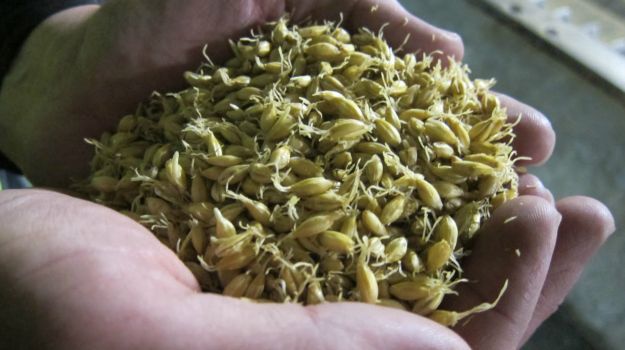A farmer holds a handful of germinating barley. Credit: Copyright John MallettMalt is a fairly mysterious ingredient, but craft beer is about to change that.
Like milling helps turn wheat into bread, malting helps turn barley and other grains into beer. Malting is the process of germinating (sprouting) and then kilning grains, which allows access to the starches and enzymes necessary for fermentation.
The importance of malt
Malt's job is not strictly functional, though. Different types of malt contribute flavors and other elements to the final product. Malt is to beer what stock is to soup, as brewer John Mallett writes in his book, "Malt: A Practical Guide from Field to Brewhouse."
"As craft beer has exploded in popularity, hops have often been seen as the sexy ingredient in beer," he says. Mallett is the director of Bell's Brewery in Michigan. "On first glance, malt seems kind of dull, but it actually contributes the key attributes that largely define beer, including color, flavor, foam, body and, eventually through fermentation, alcohol."
Craft malthouses opening
At one time, malting was a domestic chore, same as baking bread. Prohibition and changes in farming helped consolidate the industry and put the production largely out of sight. Now, in response to curiosity about this ingredient, craft malthouses are opening across the nation. New York State has more than its fair share.
This is because New York created a friendly environment for micro and nano brewing with the Farm Brewery Law. This licensing, which went into effect at the beginning of 2013, requires that breweries use a percentage of state-grown products. A revival of hops production was already underway, and the law nudged along the boom in malt. Nine malthouses are in operation across the state, and more are in the works.
Brewing at the local level
"It's been exciting learning a whole new skill, one that's been pretty much forgotten," says Bob Johnson, who runs Niagara Malt. A professor of plant ecology and biochemistry at Medaille, a small liberal arts college in Buffalo, Johnson also grows hops, and farms and malts barley. "Malting is relegated to big commodity houses, and it's nice bringing this whole process... to the local level."
Buffalo had several malthouses, he notes, and three of its mayors were maltsters. Johnson says regional products lend distinctive flavors to beer.
"Plants really have an intimate contact with the soil," Johnson says. "I'm at the base of the escarpment and all my soils are very limey; sitting at the base of a limestone cliff -- my soils are very sweet as they say. That gives a flavor. The microorganisms in soil strongly influence the health and metabolism of plants."
Setting standards
His adventures in making ingredients began with a taste for fuller flavored beers. "I realized the chemicals I was enjoying so much were from hops," he says. Intrigued, he started to look into hop farming. Three years ago he planted 1,200 plants but lost half of them to drought. Hearing rumblings of the Farm Brewery Law, he realized there was going to be a programmed demand for hops and malt. This gave him the courage to replant and buy some equipment. His hop yard covers 1 1/2 acres and has 1,400 plants.
Johnson malts in the original malting system designed by pioneering Western Massachusetts maltsters Valley Malt. This system malts 1 ton of grain at a time, carrying out all the procedures, from steeping through germination (sprouting) and kilning in a single tank.
As he explores malting, Johnson also benefits by being a member of The Craft Maltsters Guild, which was formed last year to help shape the burgeoning industry by setting standards for production, performance and sourcing, and building a network for sharing information.
Tremendous potential
Given the rise of the craft beer market, the potential for growth in small-scale malting is tremendous, and New York has created an economic architecture to help develop that potential.
Private/public partnerships are helping to build momentum. Cornell University is researching what varieties of malting barleys are suited to the climate. Greenmarket Regional Grains Project is pairing farmers, maltsters and brewers for collaborations and otherwise working to raise awareness of the local agricultural products. Entrepreneurs are seizing the opportunities in beer. New York has 210 craft breweries, and 78 of those are farm breweries.
"Farm brewers have to use 20 percent New York ingredients," says Paul Leone, director of the New York State Brewers Association. (The rate will change as the region's capacity to produce local products increases.) "The market is there automatically for that group, but beyond the license every brewery in the state would use local ingredients."
A steep learning curve
For now, use is limited by quality and price. Farming malting barley in a region that hasn't done so for almost a century is a steep learning curve. Commodity malts cost significantly less than craft malts, and beer is thirsty for grains. Even if there were no difference in price, New York could not supply all its breweries. The largest of the new craft-malting facilities in the state only produce three tons a week. A ton of malt can only make about 13 to 15 barrels of beer, or about 26 to 30 kegs.
"What's unique about New York State and craft beer is that at one point we owned the hop industry. It's a natural progression to own it again, or a share of it," Leone says. "Beer does have a certain terroir. The barley that's grown here and the way that its malted here is going to be a little different than when it's from out West, same as the hops. Brewers have an ability to engineer their own flavor profile that's uniquely New York."
Copyright 2016 Amy Halloran via Zester Daily and Reuters Media Express





